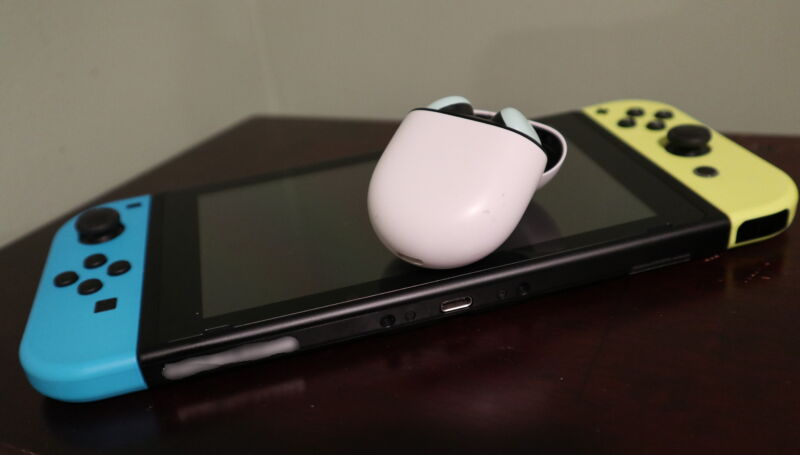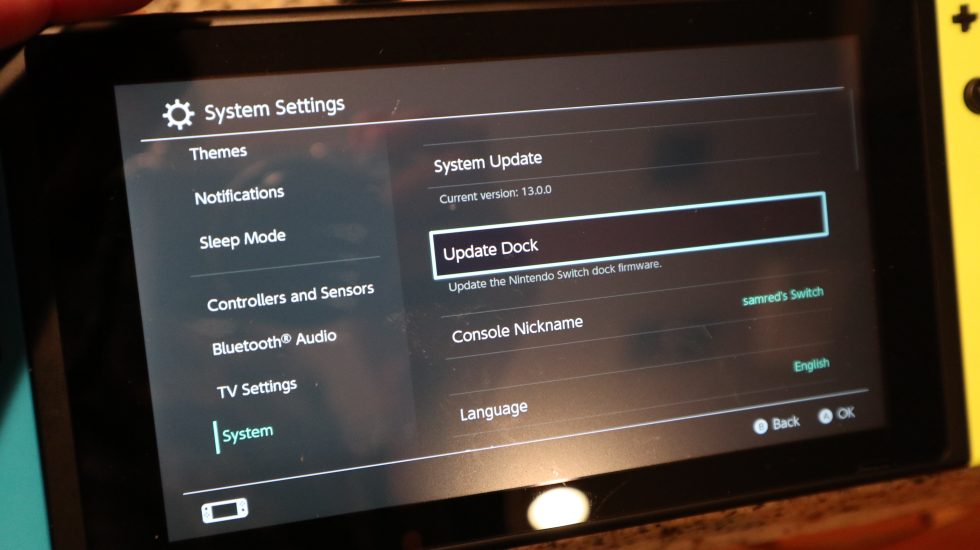
In an out-of-nowhere Tuesday evening update, Nintendo reversed course on one of the Nintendo Switch's biggest limitations: its lack of Bluetooth audio support. Bluetooth functionality is now live through the system's 13.0 firmware, which is available for download across all Switch regions.
Until this update, Switch consoles had a portable-audio capability that was the exact opposite of smartphones like the iPhone, in that the Switch only worked with wired headphones via the console's built-in 3.5 mm headphone jack. In handheld mode, that limitation was more bearable because the system was in your hands, so a corded headset made a little more sense.
With the Nintendo Switch docked to a TV, on the other hand, headset options became more limited. Without Bluetooth audio support, Switch users needed to either run a 3.5 mm extension cord to their entertainment center or use a pair of wireless headphones with a Switch-compatible USB dongle, which would have to plug into one of the Switch dock's open ports. Modern Xbox and PlayStation consoles offer more options for both 3.5 mm jacks in their gamepads and built-in wireless functions in the consoles themselves.
Freedom from wires—at a cost
-
A handy Bluetooth tab in the settings menu.
-
This is followed by a list of available audio devices that your Switch can pair with.
The Switch's 13.0 update makes it simple enough to get your Bluetooth headphones connected to the console. Open the Switch's settings menu, pick the new dedicated "Bluetooth" tab, and go into a pairing menu. Get your headphones into their "pairing" mode, and they should appear on your Switch's screen. It works like pretty much every other Bluetooth pairing interface you've ever seen.
Each Switch console supports up to 10 saved Bluetooth pairings, though only one Bluetooth headset can actively connect to a Switch at any given time. Speaking of limits: while in Bluetooth audio mode, only two "controllers" can connect to a Nintendo Switch at one time, and Nintendo says that a single pair of Joy-Cons counts as two controllers. So if you'd like to use Bluetooth audio while playing with a second person, both people will either need to turn a Joy-Con to the side or choose "Pro"-style gamepads instead.
That clash between headsets and Switch gamepads is arguably a byproduct of the Switch's Bluetooth support all along, as the system uses a Bluetooth 4.1 controller to talk to its wireless gamepads. Even if the Switch Bluetooth controller's bandwidth is limited, however, it saves some latency by blocking one major Bluetooth feature. The Switch disables all Bluetooth headset microphones by default (though Switch games generally don't support microphone audio, anyway).
Despite that attention to Bluetooth bandwidth, Nintendo hasn't magically solved an inherent issue with some Bluetooth headsets: laggy audio. My tests with both Google Pixel Buds and Surface Headphones turned up noticeable delays between on-screen action and the sounds triggered in my Bluetooth-connected headsets—enough of a delay that you would return a TV set if its audio was so staggered.This would have been a great time to lean on one of my newer Bluetooth options, Razer's True Wireless Earbuds, which offer a battery-draining low-latency audio mode as an option. Sadly, my Switch refused to recognize those earbuds while in pairing mode, even though I was able to successfully pair the Razer buds moments later on a nearby laptop. The Switch's Bluetooth interface doesn't list Bluetooth devices that don't fit into a certain "audio-only" category, arguably to stop Switch owners from getting creative and connecting mice, keyboards, or other input devices. (Xbox still wins on that front.)
One Ars staffer was able to connect Airpods Pro to his own Switch, which probably bodes well for general device support, but you may run into your own trial-and-error issues with lesser-known headset options.
Firmware for... more firmware?

The firmware update also delivers a funky menu toggle we haven't previously seen on the Switch: an option to push additional firmware updates to the Switch dock. This feature probably has something to do with the launch of the OLED Switch later this year, as its dock includes a brand-new built-in wired Ethernet adapter, whose functionality may eventually need software updates. [Update, 11:15 a.m. ET: Nintendo's patch notes confirm this is exactly the case, and they also mention connectivity tweaks like displaying whether your wireless connection is 2.4 GHz or 5 GHz. This week's system update includes a new joystick calibration method as well, though it's unclear whether this feature will remedy the console's notorious joystick drift issues.]
Still, the mode toggle is a curious addition to see in the wake of rampant Switch Pro rumors, which suggested as recently as March that a more powerful system dock would include an Nvidia DLSS hardware solution of some sort, meant to upscale lower-res Switch games to resolutions nearing 4K on TV sets. Nintendo has made it clear that the upcoming Switch OLED will deliver the same power as existing Switch systems, and it in no way sneaks mid-generation updates to the hardware. But if Nintendo wanted to quell conspiracy theories about high-tech Switch docks to come, this path to upgradeable dock firmware isn't helping.
reader comments
98